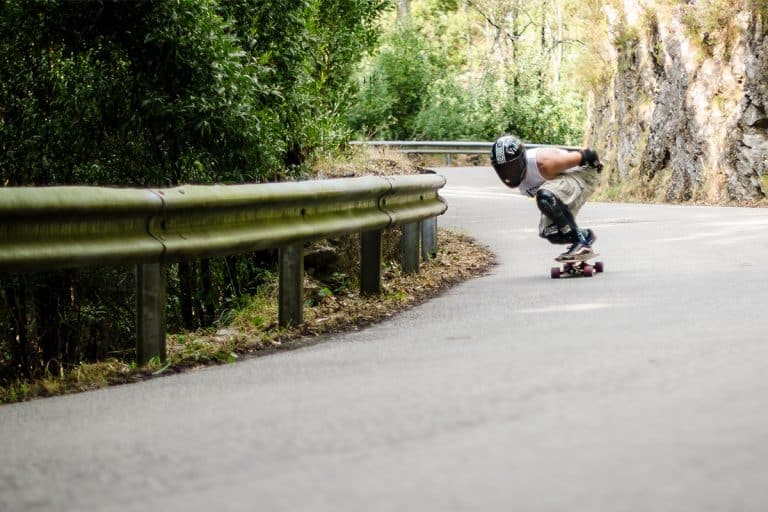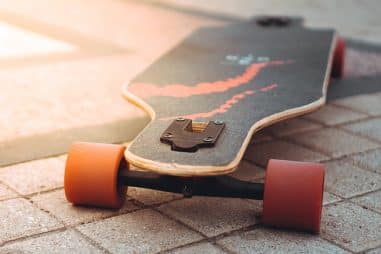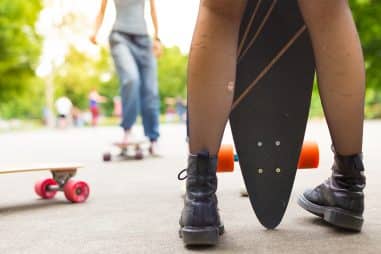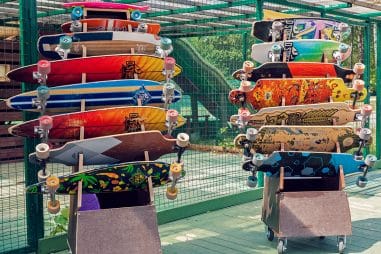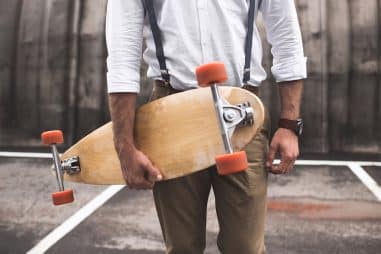There is no denying it; downhill longboarding is as exhilarating as flying. But no matter how fun this activity is , you still need to take extra care so as not to end your downhill ride in the hospital.
How Do I Choose a Downhill Longboard?
If you are a beginner boarder thinking of learning how to ride downhill or a pro boarder wanting to master the art of downhill longboarding, you should keep in mind the following to help you choose the perfect longboard for you:
- Deck Style: While you can use any deck style, some are still more ideal for downhill longboarding. For beginners, it is advisable to get a board that has a lower platform because the center of gravity is lower which makes the board more stable.
- Deck Dimensions: You should get a deck measuring between 37 to 43 inches, anything shorter would make your downhill ride unstable. Longer decks would also be easier to maneuver at high speeds. Also, choose a deck whose width is in the 9 to the 10.5-inch range.
- Truck Design: Trucks come in different styles but there is one ideal choice for downhill longboarding. The reverse kingpin, which is also called the longboarding truck, is best for handling high speeds because they turn smoothly and behave predictably.
- Truck Width: The trucks should be sized at around 180 millimeters or 10 inches. They should be placed as closely as possible to the width of the deck.
- Proper Downhill Wheels: You should also pay attention to the wheels of your board. There are several factors that make a wheel ideal for downhill longboarding.
- Lip Profile: You should choose downhill wheels that have sharp lips because they will give you more grip while still being able to slide with your board.
- Diameter: The wheels should also be sized between the 70 to the 75-millimeter range. Anything smaller can be worn out too quickly while bigger wheels will be more likely to wheel bite.
- Durometer: You should also pick wheels having lower durometer or soft wheels because they have better grip. This depends on your weight but the 80-86a is a good range.
- Core Placement: You can choose between centerset, sideset, and offset. While the centerset is great for sliding and the sideset has a smother slide initiation, offset has the marriage of both and seems to be the ideal core placement for downhill sliding.
- Wheel Width: For starters, it is best to get wheels wider than at least 50 millimeters. Any smaller and it may leave you sliding out on corners while wider wheels can be harder to initiate slides with especially if you want to slow down.
What Type of Longboard is Best for Downhill?
Pro downhill boarders prefer decks with lower platforms because they are more stable especially at high speeds.
Two of the most ideal downhill longboard types are drop through and top-mount decks. These are recommended by experts because of their lower center of gravity which proves useful during downhill rides.
Are Drop Through Longboards Good for Downhill?
Drop through longboards are great for downhill rides especially for beginners. The deck of drop through longboards is designed to sit closer to the ground which lowers their center of gravity giving it superior stability.
The positioning of the deck also helps you in getting used to riding at high speeds. They are also easier for beginners to maneuver.
What Are the Best Downhill Longboard Wheels?
If you are looking to upgrade your longboard wheels or you have no idea on what to get, here’s a short list of the top-rated longboard wheels to help you decide:
- Sector 9 Race Steam Roller 73mm 8a Blue Center Set Skateboard Wheels: This set of wheels can carry your momentum and can easily roll even on rough pavement. These are one of the highest quality downhill longboard wheels that will give you both speed and stability.
- Orangatang Kegel 80 mm 80a Downhill Longboard Skateboard Cruising Wheels w/ Loaded Jehu V2 Bearings: This set of wheels is designed for maximum speed and grip due to its sharp lip. It also has no problem plowing through rough roads and pavements. It also has a 46-millimeter core which helps in reducing weight allowing you to go faster and to perform crisp slides.
- Seismic Speed Vent 85mm 77a Bubblegum Defcon Wheels: This set of wheels is great at maximum speeds. Its weight-saving hub also allows for the quickness and agility that smaller wheels possess. These wheels give you balance, speed, and control.
Is Downhill Longboard Dangerous?
Longboarding in itself is a dangerous sport, but downhill longboarding takes it up a notch. It is an extreme sport that puts speed front and center.
Boarders ride down on very steep hills at very high speeds that would often reach over 60 miles per hour (mph) with record speeds going beyond 80 mph.
How Dangerous is Downhill Longboarding?
Downhill longboarding is very dangerous that nasty situations can potentially be deadly. Here are some of the dangers and risks that go along with this sport:
- Crash: This is the most obvious and most common danger of downhill longboarding. When you slide at top speed it is very likely that you would crash into something.
- Road accident: When you are downhill riding in a high traffic area, chances are there would be cars around that could potentially harm you especially when you are riding on blind corners.
- Obstacles on the road: You can never too sure of the environment surrounding the area that you are riding in. Hazards like road bumps or cracks can potentially send you to the hospital.
- Equipment failure: No matter how careful you are, sometimes a few problems are overlooked. Your board can fail while you are riding which can pose a deadly threat for you who happens to be going 50 miles per hour.
These dangers are always present in your constant longboard rides, but you can reduce the risk by taking precautions. Make sure to never go without your protective gear, inspect your surroundings and your equipment, and always bring a friend with you to track your progress and safety.
How Do You Go Downhill on a Longboard?
It is not enough that you just know how to ride your longboard when going downhill riding. It is a discipline unto itself and it can be dangerous unless you know how to ride properly.
Here are some steps to follow if you want to ride downhill safely.
Step 1. Learn how to stop your board. Before even rolling, you must first know who to stop your longboard if you are in a sticky situation on your way down. There are several ways on how to do this including footbrake, tailslide, and heel-slide.
Step 2. Adjust your trucks. Make sure that your front trucks are looser than the back trucks. The proper adjustment of your trucks will help you carve or turn easier.
Step 3. Learn downhill tucking. It is a defined position in which you make yourself as small as possible in order to reach maximum speed. You essentially “tuck” yourself onto itself you reduce wind resistance and stabilize your body on your board.
Step 4. Calmness is key. Stay relaxed and loose while downhill riding. If you are nervous, there is a chance that your muscles will tense up causing you to over current your turns.
Step 5. Ride smoothly. Keep your position and stay Zen. Downhill longboarding may be scary but it sure is a lot of fun.
How Do You Stand Downhill on a Longboard?
The stance is a fundamental aspect of longboarding. There are different stances for all kinds of longboard riding styles, and there is a special stance for downhill longboarding.
The downhill tucking (also commonly referred to as “tuck”) is a position that minimizes wind resistance while maximizing your speed.
In order to execute this, you need to position your body properly.
- Your front foot should be on the front truck.
- Your back foot (which is on its toes) behind your front foot should be angled close to the rail.
- Both knees should be in a 90-degree bend with your back knee positioned at the back of your front calf.
- Lean forward with your chest tucked horizontally on your front thigh
- Position your arms behind your back.
How Do You Slow Down Going Downhill on a Longboard?
Here are some ways on how to slow down your longboard when going downhill:
- Increase your wind resistance: While on the tuck, slowly exit out by straightening your upper body and using it as a sail. Slowly exiting out of your tuck would cause more wind resistance that would help decrease your speed.
- Carving Uphill: While this is probably the easiest method to slow down, you need skills and ample practice to execute this perfectly. While going down, make a sharp turn that would make your board move uphill, letting gravity slows your board down.
- Sliding: While going downhill, position your feet correctly on the board and simultaneously place your hand on the ground. Always remember to wear a longboarding slide glove for this.
How Do You Stop a Longboard Going Downhill?
There are several ways on how you can stop your board when you are going downhill.
- Footbrake: To do this you must take your back foot and slide it along the ground until you stop.
- Tailslide: This takes more experience because you would need to control your board. Push your back foot down on the tail until it drags along the ground. Remember to lean forward while pushing your foot down to avoid sliding out. This technique may be effective, but it might cost you the tail of your board.
- Heel-slide: In this technique, hang the heel of your back foot over the back of the tail. Your board will drag along your heel against the ground causing your board to stop
Are Longboards Supposed to Be Wobbly?
While the trucks on your longboard should be a little loose, your board is not supposed to wobble. Wobbling is a sign that your board is in trouble which may result in catastrophe, not just for your board but for you as well.
The trucks on your board should be the kind of loose that you feel comfortable in. Tightening the trucks is not advisable because this will make turning and carving hard.
Why Do I Get Wobbles on My Longboard at High Speeds?
The wobbles you get when longboarding at high speeds is called speed wobble and it is mainly caused by the oscillation of your rear trucks which happen to be a little too loose.
Speed wobbles can be triggered by different factors including road imperfections, hitting small roadblocks, or poor balance.
How Do You Control and Stop Speed Wobbles on a Longboard?
It may take some time and practice, but you can definitely learn how to control and stop speed wobbles.
- Weigh distribution: When going downhill, remember to always shift 90 percent of your weight towards the front end of your board and keep the center of your gravity low to stay stable.
- Initiation turns: If you are in the wobble, initiate a carve but remember to do it slowly because if you carve fast there is a chance that you will amplify the wobble.
- Stay calm: Keep your muscles relaxed because one cause of speed wobbles is stiff muscles. Let your legs be loose and relaxed so that you will stop overcorrecting.

